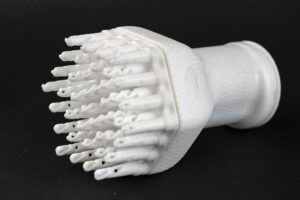As a manufacturer, securing sustainable material supplies is crucial, especially in the realm of medical device manufacturing. However, unforeseen risks like supply chain disruptions can impede this process, and the medical industry is no exception. When the COVID-19 pandemic hit, the sudden surge in demand for personal protective equipment (PPE) and nasopharyngeal swabs led to widespread supply chain disruptions. In response, the medical device manufacturer turned to an alternative solution: 3D printing medical swabs.
The Stratasys Origin One 3D printer, designed specifically for medical device manufacturing, was identified as the ideal solution for the rapid development and production of 3D-printed swabs. Leveraging medical-grade materials from Stratasys’ ecosystem, including those from multiple global chemical companies, the manufacturer swiftly developed FDA-compliant 3D-printed swabs. These swabs underwent rigorous clinical testing and demonstrated high efficacy, comparable to traditional counterparts.

Unlike traditional injection molding processes with lengthy lead times, 3D-printed medical swabs transitioned from clinical trials to mass production within days. Utilizing the internal capacity of the Origin One 3D printer, the manufacturer was able to print 800 swabs per printer daily. Within eight weeks, over half a million fully validated swabs were shipped and promptly deployed across healthcare facilities and testing centers nationwide.

During this critical period, Origin’s technology also facilitated the production of thousands of units of PPE, respirator components, and ventilator components, showcasing its versatility in addressing diverse supply shortages in medical equipment manufacturing.
The Stratasys Origin One, functioning as a medical 3D printer, with its advanced printing technology and access to high-performance materials, can enable fast iterations and accelerated concept development, making it the preferred choice for rapid production of biocompatible components for medical equipment manufacturers. Its swift response during the pandemic underscores the transformative potential of 3D printing in overcoming supply chain disruptions and saving lives.






